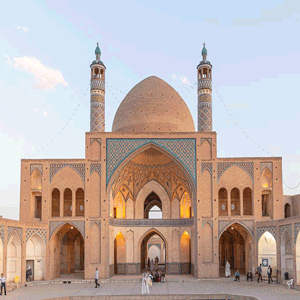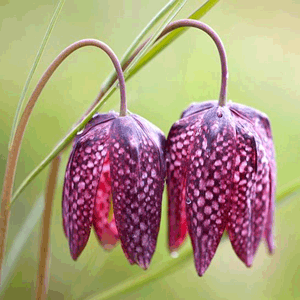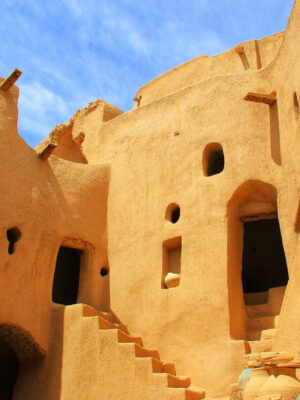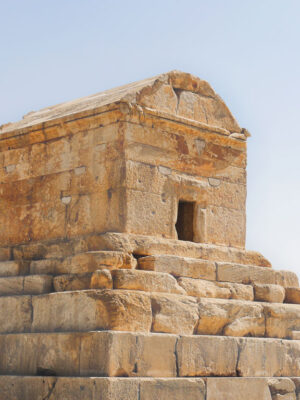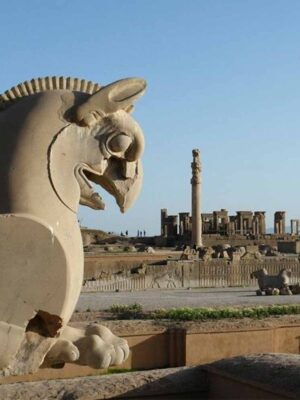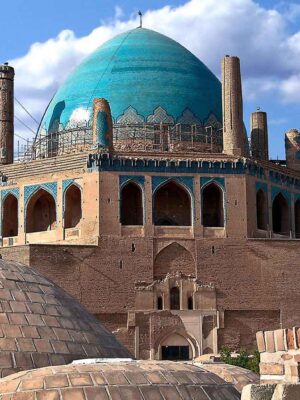Tchogha Zanbil
Chogha Zanbil is located 40 kilometers southwest of Susa in Khuzestan province on an expansive arid plateau. This fascinating complex which includes the remains of the sacred city the Elamite king Untash-Napirisha (1275-1240 BCE) built for his residence. It was likely his intention to establish a temple-city on a pristine plain, where, from its summit the capital Susa would be visible and reached within a day’s walk. Untash-Napirsha’s aspiration was to consolidate the religions and rituals of the Elamite states in one place, thereby, creating profound solidarity between state and religion. However, the city was never completed or settled before it was demolished by the Assyrian king Ashurbanipal around 640 BCE. Chogha Zanbil is a relic of middle Elamite period II (1400-1100 B.C) also known as the Golden Age of Elam. After Untash- Napirsha’s death Chogha Zanbil was a grand pilgrimage center where people assembled for New Year’s celebrations and religious ceremonies.

Chogha Zanbil or Dur Untash (City of Untash in Ealmite) was shielded by three concentric enclosure walls, with an outer wall about 4 km in circumference encasing an area of about 100 hectares that included an extensive complex of residences, the royal quarter, and tomb-palaces. The second wall protected the temples (Temenus) dedicated to the Elamite gods and divinities; and the inner wall (105.2 m2) enclosed the focus of of the ensemble, the mud-brick ziggurat. This is the biggest ziggurat outside Mesopotamia and exceptionally well-preserved. Originally it stood 53 meter in height (currently 24.75 meters high), built in five levels, and topped with a temple. According to inscribed bricks used in the ziggurat, it was dedicated to Elamite gods Inshushinak and Napirisha. The ziggurat and many of the buildings at Chogha Zanbil were built and lavishly decorated using gypsum plaster, vaults, faience and glass.
There is no concrete theory about ziggurats. Most likely they were built to bring the heavens closer to earth, to promote the presence of God on earth. In the level plains of Mesopotamia and southwestern Iran, the eminent and multi- level structures like ziggurats were akin to ladders to the sky. Ziggurats were a place for mankind to host his creator between the heavens and earth, while avoiding contact with the inferior earth.
The knowledge gained from Chogha Zanbil has significantly expanded our understanding about the culture, beliefs and traditions of one of the oldest indigenous peoples of Iran, the Elamites, whose culture endured into the trailblazing Achaemenid Empire, the First Persian Empire.
Tchogha Zanbil
Chogha Zanbil is located 40 kilometers southwest of Susa in Khuzestan province on an expansive arid plateau. This fascinating complex which includes the remains of the sacred city the Elamite king Untash-Napirisha (1275-1240 BCE) built for his residence. It was likely his intention to establish a temple-city on a pristine plain, where, from its summit the capital Susa would be visible and reached within a day’s walk. Untash-Napirsha’s aspiration was to consolidate the religions and rituals of the Elamite states in one place, thereby, creating profound solidarity between state and religion. However, the city was never completed or settled before it was demolished by the Assyrian king Ashurbanipal around 640 BCE. Chogha Zanbil is a relic of middle Elamite period II (1400-1100 B.C) also known as the Golden Age of Elam. After Untash- Napirsha’s death Chogha Zanbil was a grand pilgrimage center where people assembled for New Year’s celebrations and religious ceremonies.

Chogha Zanbil or Dur Untash (City of Untash in Ealmite) was shielded by three concentric enclosure walls, with an outer wall about 4 km in circumference encasing an area of about 100 hectares that included an extensive complex of residences, the royal quarter, and tomb-palaces. The second wall protected the temples (Temenus) dedicated to the Elamite gods and divinities; and the inner wall (105.2 m2) enclosed the focus of of the ensemble, the mud-brick ziggurat. This is the biggest ziggurat outside Mesopotamia and exceptionally well-preserved. Originally it stood 53 meter in height (currently 24.75 meters high), built in five levels, and topped with a temple. According to inscribed bricks used in the ziggurat, it was dedicated to Elamite gods Inshushinak and Napirisha. The ziggurat and many of the buildings at Chogha Zanbil were built and lavishly decorated using gypsum plaster, vaults, faience and glass.
There is no concrete theory about ziggurats. Most likely they were built to bring the heavens closer to earth, to promote the presence of God on earth. In the level plains of Mesopotamia and southwestern Iran, the eminent and multi- level structures like ziggurats were akin to ladders to the sky. Ziggurats were a place for mankind to host his creator between the heavens and earth, while avoiding contact with the inferior earth.
The knowledge gained from Chogha Zanbil has significantly expanded our understanding about the culture, beliefs and traditions of one of the oldest indigenous peoples of Iran, the Elamites, whose culture endured into the trailblazing Achaemenid Empire, the First Persian Empire.






